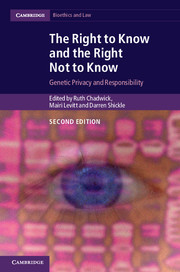Book contents
- Frontmatter
- Contents
- List of contributors
- Acknowledgements
- Introduction
- Part I Philosophical and legal issues
- Part II Issues in genetics
- 4 Biobanks and feedback
- 5 Suspects, victims and others: producing and sharing forensic genetic knowledge
- 6 Empowered by choice?
- 7 DIY genetics: the right to know your own genome
- 8 Genomics, inconvenient truths and accountability
- Part III Emerging issues
- Index
- References
4 - Biobanks and feedback
Published online by Cambridge University Press: 05 September 2014
- Frontmatter
- Contents
- List of contributors
- Acknowledgements
- Introduction
- Part I Philosophical and legal issues
- Part II Issues in genetics
- 4 Biobanks and feedback
- 5 Suspects, victims and others: producing and sharing forensic genetic knowledge
- 6 Empowered by choice?
- 7 DIY genetics: the right to know your own genome
- 8 Genomics, inconvenient truths and accountability
- Part III Emerging issues
- Index
- References
Summary
‘Genes now tell doctors secrets they can’t utter’ was the dramatic title of the New York Times article from August 2012 that described the problem of incidental findings in genetic research. Indeed, the issue of whether or not to disclose significant genetic information to participants of research that generally do not expect it, is a much-discussed topic in medical ethics and genetic journals and has now spilled over into general media. The right to know or not to know discussion in relation to biobank research is now almost entirely dominated by the so-called ‘incidentalome’ debate. Incidental findings are a well-known phenomenon in clinical care where, for example, a radiologist might find something unexpected from an image in addition to the information she was looking for. Genetic research, which is often based on biobank collections, is now similarly faced with such findings when researchers stumble upon DNA information that, while not the aim of the research itself, might be potentially very relevant to the donors. But while it might have been relatively straightforward for the radiologist to contact the patient or patient’s physician regarding incidental finds, the matter is much more complicated for researchers far removed (both institutionally and geographically) from the biological owners of the mostly anonymized samples.
The possibility of disclosing unplanned, unexpected and yet important genetic information to biobank donors raises numerous scientific, ethical, legal and practical issues. Leaving aside the legal aspects, this chapter gives an overview of these challenges and situates the debate within a larger, long-anticipated phenomenon of personalized medicine. I will start by looking back at the debates we had ten to fifteen years ago in relation to biobanks and potential feedback and will then proceed to discuss the recent arguments regarding feedback in the context of population biobanks and other large-scale genomic research.
- Type
- Chapter
- Information
- The Right to Know and the Right Not to KnowGenetic Privacy and Responsibility, pp. 55 - 69Publisher: Cambridge University PressPrint publication year: 2014
References
- 3
- Cited by

